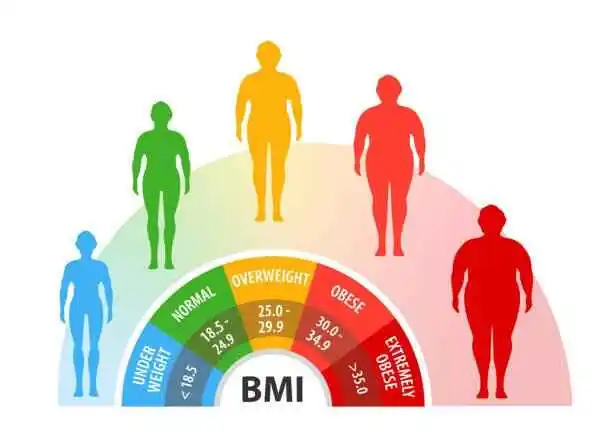Obesity Body Mass Index
A key tool used to assess obesity is the Body Mass Index (BMI), a simple numerical measure of a person’s weight in relation to their height. Developed as a standardized method for categorizing weight ranges, BMI is widely used in clinical, epidemiological, and public health settings.
Overview
The height of a person and composition (weight) are used to determine their body composition index (BMI). The Obesity body mass index (BMI), which has a value in kilograms (kg) and height in meters (m), can be determined by calculating the body size by a quarter of the height. The result is kg/m2.
Two bowls or plates that are hanging from an upright at equal spacing form a standard scale. When the weights placed on the two identical panels are equal, mechanical equilibrium becomes possible and the plates drop off.
There is just one surface with a poorly defined mass or gravity. The ideal scale lies in the middle. The stiffness (or spring constant) of the spring influences how much it will when a specific mass is attached.
Obesity is an element of a double epidemic of inadequate nutrition, and the prevalence of individuals who are obese is presently higher than the number of underweight persons in all regions except the southern part of Asia. Previously thought to be a problem exclusive to wealthy nations, some middle-income nations now have some of the highest rates of overweight and obesity in the world.
What is the function of BMI?
BMI is an index of risk for specific medical disorders and a measure used by healthcare professionals to assist diagnose weight types.
Using BMI to Diagnose Weight Types
Typically, numerous body groups are classified using the following BMI ranges (in kg/m2):
- Underweight: Less than 19
- Optimum range: 17 to 23
- Overweight: 26 to 29
- Class I obesity: 31 to 33
- Class II obesity: 34 to 36
- Class III obesity: More than 43
Organizations categorize weight categories using a variety of methods including BMI. Other supplies consist of:
- calculating the circumference of the waist.
- Use skinfold calipers to measure the thickness of the skin in specific areas of your body, such as the back of your upper arms and under your shoulder blades.
- The atmospheric displacement method (ADP) and DEXA imaging are less frequently utilized.
Measuring BMI as an indicator of health concerns
You might be more vulnerable to the following conditions if your BMI is less than 19 (underweight):
- Malnutrition.
- Anemia.
- weakened immune system, which could result in further diseases and infections.
- Osteoporosis.
- Infertility.
To assess your general health and determine whether you are malnourished, your healthcare practitioner may probably take specific blood tests and additional tests if you are underweight.
Typically, the following conditions are more inclined to affect you if your BMI is more elevated:
- Heart disease.
- High blood pressure (hypertension).
- Type 2 diabetes.
- Gallstones.
- Osteoarthritis.
- Sleep apnea.
- particular kinds of cancer, such as gallbladder, uterine, breast, and cancers of the colon.
- sadness and related emotional conditions.
It’s crucial to keep in mind that you can have any of the following illnesses without having a high body mass index. It’s also possible to have a high BMI without any of these issues. These disorders are largely influenced by genetics as well as other factors, like cigarette smoking.
Your doctor will probably prescribe specific blood tests, including a lipid panel and a comprehensive metabolic panel, to assess your general health if your BMI indicates that you may be obese.
How is my BMI determined?
By following these methods, you may determine your individual BMI:
- You can multiply your weight in kilograms by 705 by that value.
- One foot is approximately twelve inches, subsequently, divide that response by your height in inches.
- Reduce the result by your height in centimeters one more time.
In this case, the formula that follows would be used for determining the BMI of a person who weighs 180 pounds and is 5 feet 5 inches tall (65 inches total):
- 180 x 703 = 126,540.
- 126,540 / 65 = 1,946.769.
- 1,946.769 / 65 = 29.95.
They would have a BMI of 29.9.
What BMI is considered healthy?
It is generally accepted that a healthy BMI falls between 17.3 and 23.2.
It is important to keep in mind that abdominal fatness is merely one aspect that influences overall health. Your general health and your risk of contracting specific medical diseases are influenced by some further factors, including your genetic background, level of activity, use of tobacco products, alcohol consumption, smoking cigarettes, and mental health issues.
What are BMI’s obstacles?
The standard BMI chart has various limitations. This is why it’s important to avoid providing your BMI an excessive amount of weight.
Medical providers continue to use the BMI chart because it’s the easiest and fastest way to calculate an individual’s estimated body fat percentage, even though it may not be correct for some people.
Complications of diagnosing weight types with BMI
- BMI does not discriminate both fat mass and muscular mass, which is the weight that comprises all tissue in your body excluding fat. As a result, a person may have a high BMI and be powerful, but they might also have a low amount of body fat, and the reverse is true.
- Adults assigned female at birth (AFAB) and adults assigned male at birth (AMAB) utilize the same BMI chart, although adults assigned AFAB tend to have higher body fat than adults assigned AMAB.
- The BMI data doesn’t take advantage of the increasing typical length of adults as time progresses.
The typical BMI chart should not be used to determine the body fat percentage in groups as follows:
- Athletes and bodybuilders.
- Children and teenagers.
- Pregnant people.
- People over the age of 65.
- People with medical problems that cause muscle atrophy (consuming).
The disadvantages of using BMI as a health condition diagnostic method
There are significant disadvantages to using the BMI as a screening tool to determine a person’s risk of developing certain diseases, such as heart disease and Type 2 diabetes. These include:
- The BMI does not account for the location and distribution of body fat. This is problematic because gaining too much weight in some areas of your body, like your belly, is connected with a higher risk of obtaining particular medical conditions than gaining too considerable weight in different regions, particularly your lower extremities.
- Factors like familial length (average lifespan), family history of diabetes, high blood pressure, cardiovascular disease, and high cholesterol (dyslipidemia), as well as family history of cancer, are sometimes overlooked in the association between BMI and death rate.
FAQs
Which BMI is appropriate for my age?
If you weigh fewer than 16.2 pounds, you may be very underweight and nutrition. The healthy weight range for young and middle-aged individuals is between 16.5 and 23.9, which is where you fall. Your weight ranges from 24.0 to 27.9. If you are over thirty years old, you are overweight.
How can I figure out my most effective weight?
The new calculations for optimal weight state that weight in pounds is equal to BMI + (BMI divided by 5) x (Height in inches reduced by 60).
How can my BMI be reduced?
It’s essential to cut back on your regular calorie intake. Controlling your calorie consumption is one of the best strategies to reduce your BMI and lose weight.
Avoid crash diets at all costs. Even though they could tempt you with their immediate benefits, crash diets aren’t a long-term solution and can even be harmful to your health.
Get more exercise and eat more fiber.
Why is BMI important?
Your body mass index (BMI), which measures body fat, is a good indicator of your risk for diseases linked to excess body fat. Your body mass index (BMI) raises your risk of getting certain diseases, such as heart disease, high blood pressure, type 2 diabetes, gallstones, respiratory problems, and some types of cancer.
What is a healthy weight?
For an adult to be classified as healthy, the body mass index (BMI) should typically range from 18.5 to 24.9.
References
- Professional, C. C. M. (2024c, October 28). Body Mass Index (BMI). Cleveland Clinic. https://my.clevelandclinic.org/health/articles/9464-body-mass-index-bmi
- Shmerling, R. H., MD. (2023, May 5). How useful is the body mass index (BMI)? Harvard Health. https://www.health.harvard.edu/blog/how-useful-is-the-body-mass-index-bmi-201603309339
- Body mass index: MedlinePlus Medical Encyclopedia. (n.d.). https://medlineplus.gov/ency/article/007196.htm
- Brazier, Y. (2023, July 26). What are the limitations of BMI? https://www.medicalnewstoday.com/articles/323543
- McCarthy, M. (2021, May 10). Experts Say BMI Measurements Are a Starting Point, Not a Goal. Healthline. https://www.healthline.com/health-news/experts-say-bmi-measurements-are-a-starting-point-not-a-goal
- Thakkar, D. (2023a, December 13). Body Mass Index (BMI) – What It Is, How to Calculate It. Mobile Physiotherapy Clinic. https://mobilephysiotherapyclinic.in/body-mass-index-bmi/




